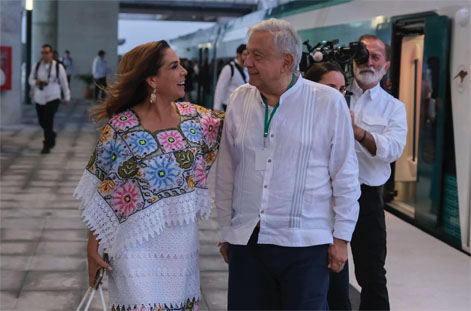|
President
Andrés
Manuel
López
Obrador
on board
passes
near
Chochola,
Quintana
Roo
State,
Mexico,
Friday,
Dec. 15,
2023.
Mexico's
president
inaugurated
a
290-mile
(473-kilometer)
stretch
between
the
colonial
Gulf
coast
city of
Campeche
and the
Caribbean
coast
resort
of
Cancun.
(AP
Photo/Martin
Zetina) |
|
|
|
|
|
 |
 |
 |
|
|
|
|
|
|
 |
|
|
The
train of
social
justice
is now a
reality!states
governor
Mara
Lezama
who was
accompanied
by
Mexico
president
Lopez
Obrador
at the
inauguration
and tour
of the
first
section
of the
TrenMaya
MX, from
San
Francisco
de
Campeche
to
Cancún. |
| |
Mexico's
president
inaugurates
first
part of
$20
billion
train
project
on
Yucatan
peninsula
MEXICO
CITY -
Mexico’s
president
on
Friday
inaugurated
the
first
part of
the pet
project
of his
administration,
a
tourist
train
that
runs in
a rough
loop
around
the
Yucatan
peninsula.
The $20
billion,
950-mile
line,
called
the Maya
Train,
is meant
to
connect
beach
resorts
and
archaeological
sites.
However,
it is
not
finished
yet.
Officials
pledged
the rest
of the
line
would be
ready by
the end
of
February.
But it
was
clear
from the
unfinished
earthworks
and the
existence
of just
a single
lane of
a
planned
double-lane
track,
even the
first
section
has not
been
completed
yet.
President
Andrés
Manuel
López
Obrador
opened a
290-mile
(473-kilometer)
stretch
Friday
between
the
colonial
Gulf
coast
city of
Campeche
and the
Caribbean
coast
resort
of
Cancun.
That is
about
one-third
of the
entire
project,
and
covers
the
least
controversial
stretch.
It will
take
about 5
1/2
hours to
travel
from
Campeche
to
Cancun
at an
average
speed of
about 50
miles
per hour
(80
kph),
though
officials
have
promised
the
train
will be
capable
of
speeds
of up to
75 mph
(120
kph).
There
will be
two
trains
per day
each
way,
with
stops in
the
colonial
city of
Merida,
the
Mayan
ruins at
Chichen
Itza and
about
ten
other
towns.
Originally,
officials
had
planned
on
charging
separate,
lower
fares
for
Mexicans
on the
line,
and
foreign
tourists
would
pay a
higher
fare.
But the
only
prices
listed
for the
first
runs
were
differentiated
only by
first-class
and
“tourist
class”
tickets,
on sale
starting
Saturday,
though
most are
sold
out.
A
first-class
ticket
on one
of the
two
trains
from
Cancun
to
Merida
each day
will
cost the
equivalent
of $68.
A
first-class
bus
ticket
on the
same
route
costs
about
$58,
with
buses
leaving
about
every
half
hour.
The
first
train
cars to
set out
Friday
were
reserved
for
officials,
dignitaries
and the
press.
López
Obrador
called
it a
record-setting
project
that
will
eventually
link
Cancun
with
beach
towns
like
Playa
del
Carmen
and
Tulum,
and
Mayan
ruins at
Calakmul
and
Palenque.
“There
are no
public
works
projects
like
this in
the
world,”
López
Obrador
said.
“It was
also
done in
record
time.”
Layda
Sansores,
the
governor
of
Campeche
state,
claimed
“the
entire
peninsula
is
breaking
out in
cries of
‘Hallelujah!’”
Unlike
the
remaining
two-thirds
of the
Maya
Train,
the part
of the
line
inaugurated
Friday
already
had an
old
train
line
running
over
much of
the
route.
Many of
the
still-unfinished
parts
were cut
through
the
jungle
and
built
over
sensitive,
relic-filled
cave
systems,
drawing
objections
from
environmentalists.
López
Obrador
has
raced to
finish
the Maya
Train
project
before
he
leaves
office
in
September,
rolling
over the
objections
of
ecologists,
cave
divers
and
archaeologists.
The
train
runs
along
the
Caribbean
coast
and
threatens
extensive
caves
where
some of
the
oldest
human
remains
in North
America
have
been
discovered.
Because
of the
region’s
limestone
geology,
it is
riddled
with
caves
that
carry
most of
its
water.
While
officials
have
touted
the
train as
utilitarian
transport
for
freight
and
local
residents,
its only
real
source
of
significant
income
would be
tourists.
However,
given
its
frequent
stops,
unwieldy
route
and lack
of
feasibility
studies,
it is
unclear
how many
tourists
will
actually
want to
buy
tickets.
“The
train
won’t
help
residents
get to
work or
school,
and
besides,
it’s
very
expensive,”
SELVAME,
a
coalition
of
groups
opposing
the
project,
said in
a
statement
Friday.
“The
train
runs
through
the
jungle,
filling
cenotes
(sinkhole
lakes)
and
underground
rivers
with
concrete,
without
any
studies.”
López
Obrador
has
tried to
rush
through
the Maya
Train
project
by
exempting
it from
normal
permitting,
public
reporting
and
environmental
impact
statements,
claiming
it is
vital to
national
security.
In
November
2021,
López
Obrador’s
government
issued a
broad
decree
requiring
all
federal
agencies
to give
automatic
approval
for any
public
works
project
the
government
deems to
be “in
the
national
interest”
or to
“involve
national
security.”
The
train
was
partly
built by
the
Mexican
army and
will be
run by
the
armed
forces,
to whom
López
Obrador
has
entrusted
more
projects
than any
other
president
in at
least a
century.
López
Obrador
is known
for his
fascination
with
trains,
the
armed
forces
and
state-owned
companies
in
general.
In
November,
he
announced
he will
require
private
rail
companies
that
mostly
carry
freight
to offer
passenger
service
or else
have the
government
schedule
its own
trains
on their
tracks.
Almost
no
regular
passenger
rail
service
remains
in
Mexico
following
a 1995
reform
that
gave
concessions
to two
private
railway
companies:
Mexico’s
Ferromex
and a
subsidiary
of U.S.
railway
Kansas
City
Southern.
A few
tourist
trains
run on
relatively
short,
unconnected
routes
to
tourist
attractions
like
northern
Mexico’s
Copper
Canyon
and the
western
tequila-producing
region
around
Jalisco.
____
Follow
AP’s
coverage
of Latin
America
and the
Caribbean
at
https://apnews.com/hub/latin-america
|
|
|
|
|
|
|
|
|